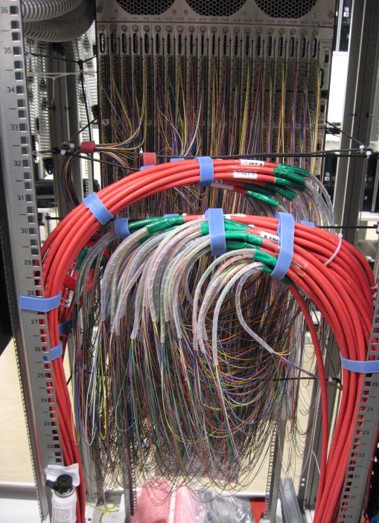Intelligentes Gebäude
How to Achieve Clean, Streamlined Cable Bays for Matrix Switches
24.06.2021
If you've ever been involved with a mid- to large-scale fiber optic video distribution or KVM (keyboard, video, mouse) extension application, you know that managing fiber cable in the back of matrix switches can get messy. Larger switches may require up to 2,560 individual fiber optic cables to be installed.
Especially in small IT rooms with limited square footage, excess cable length quickly builds up and makes switch access difficult. It also makes it very easy to lose track of what each cable connects to.
In many environments, including government and defense applications, it's vital to be able to identify the purpose of individual fibers-and where they're being routed to. Each cable may serve a different purpose and hold a different security classification based on the sensitivity of the information transmitted (confidential, secret or top secret, for example).
For matrix switch applications, horizontal managers are typically used to organize cables within the same chassis as well as between different racks and enclosures. To keep them out of the way, cables are tie-wrapped when needed.
When it comes to cable options, you can choose between individual patch cords or harnesses (bundles of protected and contained cables). Most harnesses have standard-length legs, which results in excess slack. And using patch cords poses its own cable-management challenges, including lots of congestion. Patch cords aren't designed to be pulled, which can also create installation issues.
We weren't the only ones to notice these cable-management problems. Our customers told us they struggled with them, too.

The bottom line: We knew—and so did you—that there had to be a better way to manage cables behind matrix switches so they would stay neat, organized and out of the way.
Here’s what we noticed about existing options—and what they lacked.
Legs were all one standard length
Because standard-length jacketed legs are used in cable harnesses, congestion builds quickly in certain areas. And because legs are 2 mm or 3 mm in diameter, their size further contributes to space constraints.
How can this be fixed? By using 1.6 mm jacketed legs to run in front of a switch instead of 2 mm or 3mm legs, reducing congestion. Preconfigured staggered legs can also be used to create a harness with leg lengths running from short to long (top-to-bottom or bottom-to-top, depending on the switch) so they fit without excess slack.
Neatness matters-especially in AV and IP applications. The tidier your cable, the more reliability you have and the easier it will be to update or make changes.
The transition points were large
Transitions are necessary when going from one fiber cable type to another. Typically, these transitions are made of heavy, hard epoxy, which makes the cable difficult to work with.
How can this be fixed? Use smaller harness/assembly transitions that feature a low-pressure mold (LPM) on the cable manager to make transition points lighter and easier to fix during installation on cable managers. This also allows important features to be incorporated, such as attachment points.
By using this technology to apply more pulling force to the cable, pulling eyes allow you to pull with up to 100 pounds of force. The pulling eye also allows for fast removal within seconds by clipping a connection tab.
Maintenance was difficult
When switch I/O (input/output) cards needed to be removed, this often impacted other I/O cards, which interrupted performance. And, depending on slack, it may have been difficult to swap out switch I/O cards in the available space.
How can this be fixed? Use harnesses with the same I/O card direction (vertical) with enough slack to enable easy removal and swapping of the switch I/O cards. When an I/O card needs to be removed or replaced, reconfiguration can happen quickly with much easier management of fiber connections. Simply keep the harness transition in the horizontal cable manager, unplug the connectors, swap out the switch I/O card and plug the connectors back in.
They lacked fiber protection
Fiber inside a cable can break if it's bent too far or crushed. If a single fiber within an assembly is broken, then the entire assembly goes down.
How can this be fixed? Use a robust solution for the horizontal cable within the harness so it can tolerate being pulled or installed on cable trays, ladders, raceways or conduit (if needed) without damaging fibers.
Improve Cable Management for Thinklogical Matrix Switches
Thinklogical Fiber Harnesses—created through a design collaboration between Belden and Thinklogical, a Belden Brand—simplify fiber installation, configuration and maintenance to and from Thinklogical Matrix Switches.

In the end, you have a fiber harness solution that offers all the benefits we’ve mentioned above: It improves cable management and eliminates excess cable behind matrix switches while offering a way to easily attach and hold harnesses that feature smaller jacketed legs.
Harnesses kits are available to fill one full switch I/O card for Thinklogical's VX80, VX320, VX640, and TLX80, TLX160, TLX320, TLX640 and TLX1280 matrix switches. Individual harness can also be obtained for specific port numbers needed for the switch I/O card for each matrix switch.
Assemblies are also completely customizable, from fiber type (OM3, OM4, OS2) and connector type needed on the harness end to build-to-order lengths.
Want to learn more? Start here.
